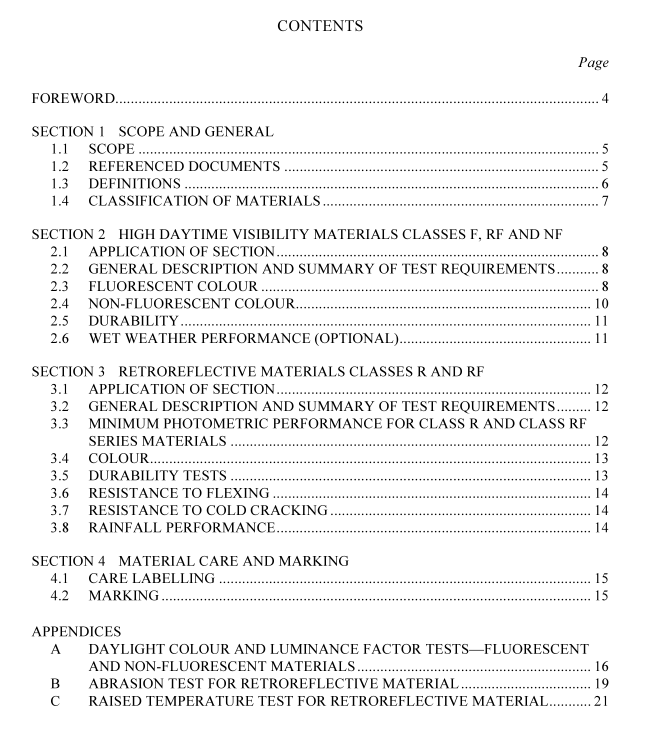AS NZS 1906.4 pdf download – Retroreflective materials and devices for road traffic control purposes Part 4: High-visibility materials for safety garments

AS NZS 1906.4 pdf download – Retroreflective materials and devices for road traffic control purposes Part 4: High-visibility materials for safety garments
1.3 DEFINITIONS For the purpose of this Standard, the definitions below apply.
1.3.1 Viewing geometry
NOTES:
1 The following are condensed versions of the corresponding definitions given in CIE 54.2. Reference should be made to the CIE document if a full set of parameters and their definitions is required.
2 An illustration showing the parameters below can be found in AS/NZS 1906.1.
1.3.1.1 Entrance angle (β) The angle between the axis normal to the retroreflector through its point of reference and the axis joining the point of reference and illumination source. The angle β has two components, β 1 and β 2 as follows:
(a) β 1 is the component projected onto the plane containing the observation angle.
(b) β 2 is the component projected onto the plane containing the axis normal to the retroreflector and which is at right angles to the plane containing the observation angle. NOTE: Since this Standard specifies that all CIL/m 2 measurements are to be taken with the plane containing the entrance angle in the same plane as the observation angle, the CIL/m 2 tabulations in Section 2 will show β 2 = 0. 1.3.1.2 Observation angle (α) The angle between the axis joining the point of reference (usually the centre) on the retroreflector (i.e. either the device or the material sample) and the observer or receptor, and the axis joining the point of reference on the retroreflector and the illumination source.
1.3.1.3 Rotation angle (ε) The angle measured from an arbitrary starting point through which the retroreflective material is rotated during the photometric testing, about an axis normal to, and passing through the centre of, the piece.
1.3.2 Light technical parameters
1.3.2.1 Coefficient of luminous intensity (CIL) The quotient expressed in candela per lux (cd.lx −1 ), obtained by dividing the luminous intensity, in the direction considered, by the illuminance at the retroreflective surface, for given observation, entrance and rotation angles. It is referred to as the ‘CIL value’. NOTE: This coefficient is applicable to devices that are effectively point sources of light at normal viewing distances.
1.3.2.2 Coefficient of luminous intensity per unit area The value expressed in candela per lux per square metre (cd.lx −1 .m −2. ), obtained by dividing the coefficient of luminous intensity of a test piece by the area in square metres of that test piece measured parallel to its surface. It is referred to as the ‘CIL/m 2 value’.
1.3.2.3 Luminance factor The ratio of the luminance of a surface to that of an ideal white diffusing surface when illuminated and viewed under the same conditions and viewing geometry. It is usually expressed as a decimal in the range 0 to 1 but values greater than 1 are possible for some fluorescent materials. It may also be expressed as a percentage.
1.3.3 Material performance parameters
1.3.3.1 Orientation sensitive material Retroreflective material that exhibits CIL/m 2 values that differ by more than 15 percent when measured at any two rotation angles 90° apart and at entrance angle β 1 = 20° and observation angle α = 0.2°.
1.3.3.2 Fluorescent material Material that emits optical radiation at wavelengths longer than absorbed.
1.4 CLASSIFICATION OF MATERIALS High-visibility materials shall be classified according to their day or night-time application, as follows:
(a) Class F High daytime visibility fluorescent material.
(b) Class F (W) High daytime visibility fluorescent material that has met both the requirements for Class F material and an optional wet weather test (see Clause 2.6).
(c) Class R Retroreflective material for use on garments used in dark conditions.
(d) Class RF Combined performance retroreflective/fluorescent material meeting all of the requirements of Class R and the daytime colour of Class F.
(e) Class NF High daytime visibility non-fluorescent material.
2.1 APPLICATION OF SECTION
The requirements of this Section shall apply to Class F, Class RF and Class NF in respect of their daytime visibility only.









